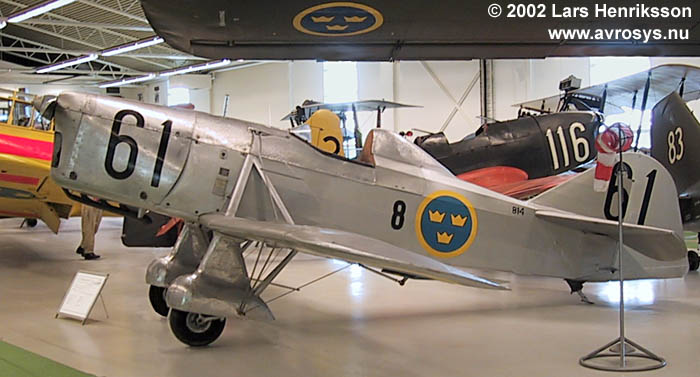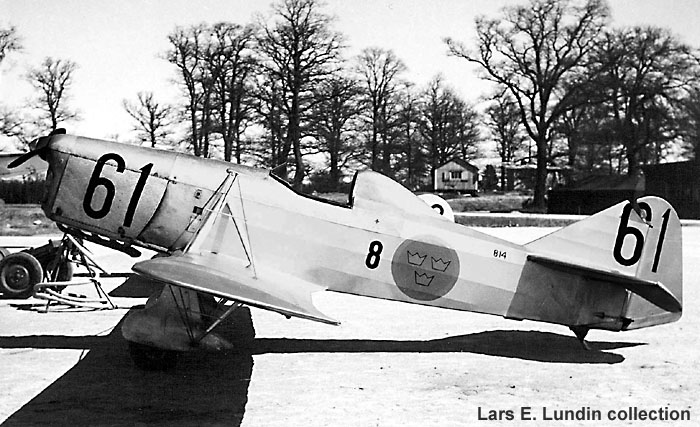|
|
||
| P 1 - Sparmann S 1-A ”Sparmannjagaren” (1939-1947) | ||
|
|
Page 1(2) |
|
|
|
||
 |
||
|
Edmund
Sparmann (1888-1951), mentioned on other pages in this website (Dront,
Ö 4, J 1 etc) as he introduced the Austrian Phönix Aircraft in Sweden,
established an aircraft factory in 1933 in Stockholm. Sparmann was born
in Vienna and was an educated engineer. He had made several inventions
in the aeronautical field, including an automatic stabilizer which was
patented in several countries and which could be used in submarines and
torpedoes as well as aircraft. During the WWI he served first in the
Austrian Army flying corps and then became chief pilot and factory
manager for Phönix-Werke in Vienna. His work also included designing
military aircraft. Before
starting his enterprise, Sparmann had lived in Sweden for many years. In
1919, when he arrived to Sweden and managed to sell the Phönix aircraft
to the Army Aviation Company, he decided to stay here and began to work
for the Thulin company and as a stuntflier. In
1926 Sparmann was granted Swedish citizenship. The same year he was
employed as a controller and test-pilot at the Malmen workshop. He was
not, however, used in the further development of the Phoenix aeroplanes.
Relations between him and the other engineers at Malmen became so
strained that he left his work in 1931. Sparmann
got at this time about 250.000 Swedish crowns from the United States as
compensation for a patent infringement during the war concerning his
patented stabilizer. He used most of the money to establish an aircraft
design bureau with a manufacturing capacity. Skilled engineers and
draughtsmen were employed. The leading engineers were Germans, but he
also got hold of some personnel from ASJA. In 1936 Sparmann had about
forty persons employed. Sparmann’s
first project was an ”trainer fighter”. He meant that such an
aeroplane would provide a training in flying fighters that was as good
as, but considerably cheaper than, training in a real fighter.
The Air Board did not accept his reasoning and declined to buy
the aeroplane. Sparmann built a prototype for his own means. The
aeroplane got a civil registration (SE-ADX) in June of 1935, but crashed
and was damaged beyond repair at an airshow the same summer. Finally in
1936 Sparmann got an order of four aircraft from the Air Force. Most of
the order was to be paid by from the fund for combatting unemployment.
This order was later followed by others. In total, Sparmann delivered
ten of his ”trainer fighters” to the Air Force. The
Air Force gave the type the designation P 1 (P = ”Provflygplan”; in English ”Trial Aircraft”). The
maker’s designation was S 1-A,
but the aircraft was usually called ”Sparmannjagaren” (”the
Sparmann Fighter”). The ten P 1 got the Air Force numbers 811-820. P
1 had a fuselage of steel tubes, covered by canvas. The wooden wings
were covered by plywood. Control surfaces were covered by canvas and
plywood. The aircraft had a wooden propeller. In wintertime, the P 1
could be equipped with skis. The aircraft was unarmed, but could be
provided with a gun camera. Some P 1’s were later modernized with a
covered cabin. Three
P 1s was delivered to the Air Force Flight Academyl at Ljungbyhed, but remained
there only for a few years. The P 1 served not very much in the intended
role as ”training fighter”. As it had a long range, it was much used
for liaison flying at various Air Force Wings around the country. The
aircraft performed very well and was easy to fly. It was a popular
”toy” among the pilots during the years of WWII. The
power plant was a 4-cylinder de Havilland Gipsy Major engine of 130 hp. Due
to lack of financial resources, Sparmann could not survive in the
competition with the larger aircraft manufacturers in Sweden. But the
government and the Air Force were willing to help Sparmann and his
personnel to be employed at the company that was eventually chosen as
Sweden’s main aircraft producer. The story ended with that Sparmann
was offered 100.000 crowns for good-will, compensation for manufacturing
equipment etc and employment for three years at SAAB. This was without
doubt a good offer, but Sparmann accepted only reluctantly. He was
regarded as being difficult to co-operate with and also showed little
interest in the new developments in the aeronautical field. The Sparmann
story ended in bitterness. Photos: Top - The only remaining P 1 - Sw AF/n 814 (c/n 8), now exhibited at Flygvapenmuseum. Bottom: The same aircraft at Såtenäs, Spring 1942. Length:
6,18 m. Span: 8,00 m. MTOW: 625 kg. Max. speed: 250 km/h
|
||
|
For the Model Builder |
|
|
|
|
||
 |
||
|
|
||
|
|
||
|
|
||
|
|
||
|
© Lars Henriksson |
|
Updated 2010-07-15 |
